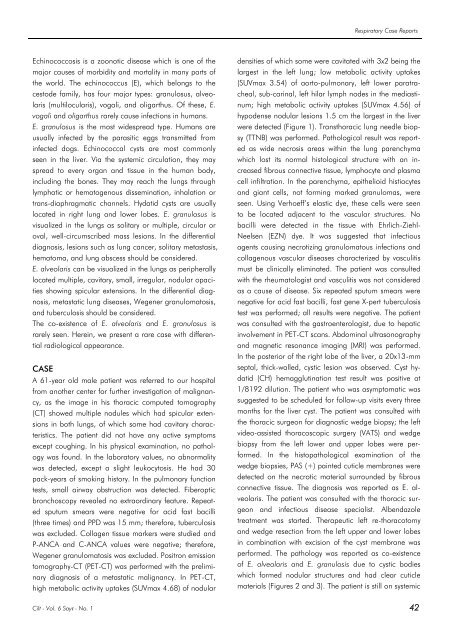Respircase Cilt: 6 - Sayı: 1 Yıl: 2017
You also want an ePaper? Increase the reach of your titles
YUMPU automatically turns print PDFs into web optimized ePapers that Google loves.
Respiratory Case Reports<br />
Echinococcosis is a zoonotic disease which is one of the<br />
major causes of morbidity and mortality in many parts of<br />
the world. The echinococcus (E), which belongs to the<br />
cestode family, has four major types: granulosus, alveolaris<br />
(multilocularis), vogali, and oligarthus. Of these, E.<br />
vogali and oligarthus rarely cause infections in humans.<br />
E. granulosus is the most widespread type. Humans are<br />
usually infected by the parasitic eggs transmitted from<br />
infected dogs. Echinococcal cysts are most commonly<br />
seen in the liver. Via the systemic circulation, they may<br />
spread to every organ and tissue in the human body,<br />
including the bones. They may reach the lungs through<br />
lymphatic or hematogenous dissemination, inhalation or<br />
trans-diaphragmatic channels. Hydatid cysts are usually<br />
located in right lung and lower lobes. E. granulosus is<br />
visualized in the lungs as solitary or multiple, circular or<br />
oval, well-circumscribed mass lesions. In the differential<br />
diagnosis, lesions such as lung cancer, solitary metastasis,<br />
hematoma, and lung abscess should be considered.<br />
E. alveolaris can be visualized in the lungs as peripherally<br />
located multiple, cavitary, small, irregular, nodular opacities<br />
showing spicular extensions. In the differential diagnosis,<br />
metastatic lung diseases, Wegener granulomatosis,<br />
and tuberculosis should be considered.<br />
The co-existence of E. alveolaris and E. granulosus is<br />
rarely seen. Herein, we present a rare case with differential<br />
radiological appearance.<br />
CASE<br />
A 61-year old male patient was referred to our hospital<br />
from another center for further investigation of malignancy,<br />
as the image in his thoracic computed tomography<br />
(CT) showed multiple nodules which had spicular extensions<br />
in both lungs, of which some had cavitary characteristics.<br />
The patient did not have any active symptoms<br />
except coughing. In his physical examination, no pathology<br />
was found. In the laboratory values, no abnormality<br />
was detected, except a slight leukocytosis. He had 30<br />
pack-years of smoking history. In the pulmonary function<br />
tests, small airway obstruction was detected. Fiberoptic<br />
bronchoscopy revealed no extraordinary feature. Repeated<br />
sputum smears were negative for acid fast bacilli<br />
(three times) and PPD was 15 mm; therefore, tuberculosis<br />
was excluded. Collagen tissue markers were studied and<br />
P-ANCA and C-ANCA values were negative; therefore,<br />
Wegener granulomatosis was excluded. Positron emission<br />
tomography-CT (PET-CT) was performed with the preliminary<br />
diagnosis of a metastatic malignancy. In PET-CT,<br />
high metabolic activity uptakes (SUVmax 4.68) of nodular<br />
densities of which some were cavitated with 3x2 being the<br />
largest in the left lung; low metabolic activity uptakes<br />
(SUVmax 3.54) of aorto-pulmonary, left lower paratracheal,<br />
sub-carinal, left hilar lymph nodes in the mediastinum;<br />
high metabolic activity uptakes (SUVmax 4.56) of<br />
hypodense nodular lesions 1.5 cm the largest in the liver<br />
were detected (Figure 1). Transthoracic lung needle biopsy<br />
(TTNB) was performed. Pathological result was reported<br />
as wide necrosis areas within the lung parenchyma<br />
which lost its normal histological structure with an increased<br />
fibrous connective tissue, lymphocyte and plasma<br />
cell infiltration. In the parenchyma, epithelioid histiocytes<br />
and giant cells, not forming marked granulomas, were<br />
seen. Using Verhoeff’s elastic dye, these cells were seen<br />
to be located adjacent to the vascular structures. No<br />
bacilli were detected in the tissue with Ehrlich-Ziehl-<br />
Neelsen (EZN) dye. It was suggested that infectious<br />
agents causing necrotizing granulomatous infections and<br />
collagenous vascular diseases characterized by vasculitis<br />
must be clinically eliminated. The patient was consulted<br />
with the rheumatologist and vasculitis was not considered<br />
as a cause of disease. Six repeated sputum smears were<br />
negative for acid fast bacilli, fast gene X-pert tuberculosis<br />
test was performed; all results were negative. The patient<br />
was consulted with the gastroenterologist, due to hepatic<br />
involvement in PET-CT scans. Abdominal ultrasonography<br />
and magnetic resonance imaging (MRI) was performed.<br />
In the posterior of the right lobe of the liver, a 20x13-mm<br />
septal, thick-walled, cystic lesion was observed. Cyst hydatid<br />
(CH) hemagglutination test result was positive at<br />
1/8192 dilution. The patient who was asymptomatic was<br />
suggested to be scheduled for follow-up visits every three<br />
months for the liver cyst. The patient was consulted with<br />
the thoracic surgeon for diagnostic wedge biopsy; the left<br />
video-assisted thoracoscopic surgery (VATS) and wedge<br />
biopsy from the left lower and upper lobes were performed.<br />
In the histopathological examination of the<br />
wedge biopsies, PAS (+) painted cuticle membranes were<br />
detected on the necrotic material surrounded by fibrous<br />
connective tissue. The diagnosis was reported as E. alveolaris.<br />
The patient was consulted with the thoracic surgeon<br />
and infectious disease specialist. Albendazole<br />
treatment was started. Therapeutic left re-thoracotomy<br />
and wedge resection from the left upper and lower lobes<br />
in combination with excision of the cyst membrane was<br />
performed. The pathology was reported as co-existence<br />
of E. alveolaris and E. granulosis due to cystic bodies<br />
which formed nodular structures and had clear cuticle<br />
materials (Figures 2 and 3). The patient is still on systemic<br />
<strong>Cilt</strong> - Vol. 6 <strong>Sayı</strong> - No. 1 42

















